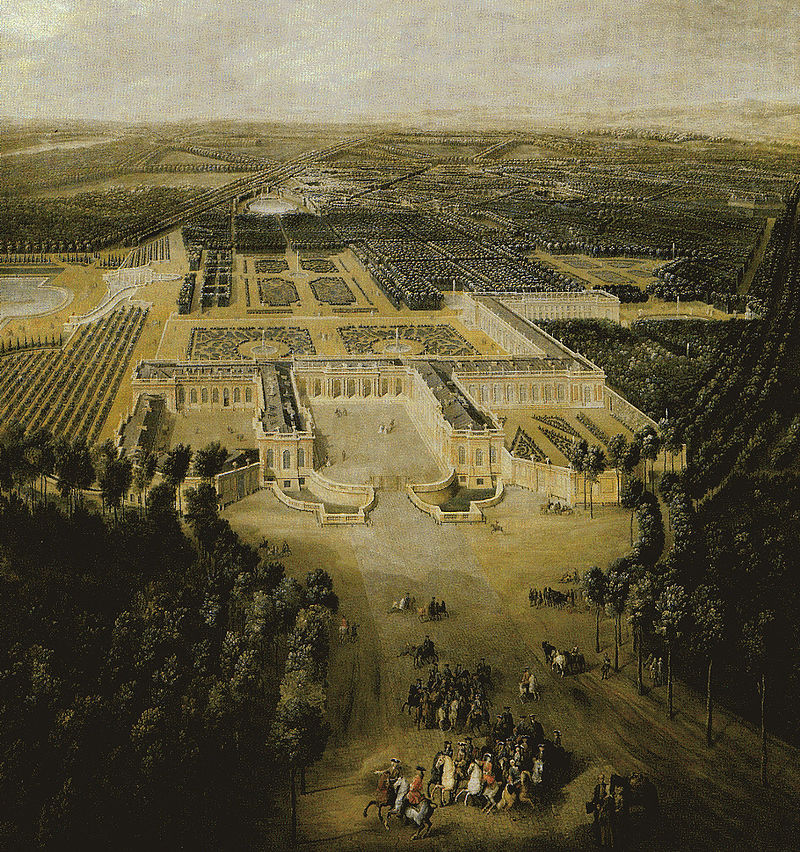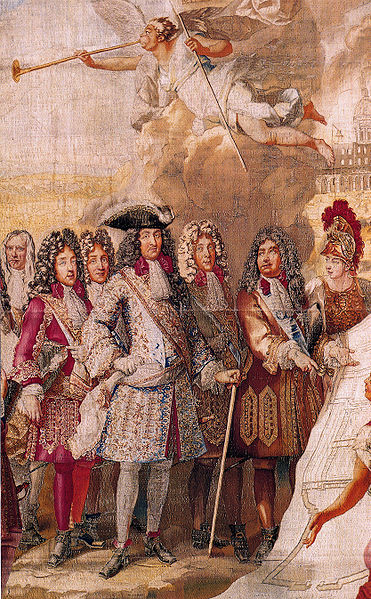La Maison Royale de Saint-Louis
The Maison Royale de Saint-Louis aka Saint-Cyr was created in 1684 by Louis XIV at request of his secret wife Madame de Maintenon and served as school for impoverished noble girls.
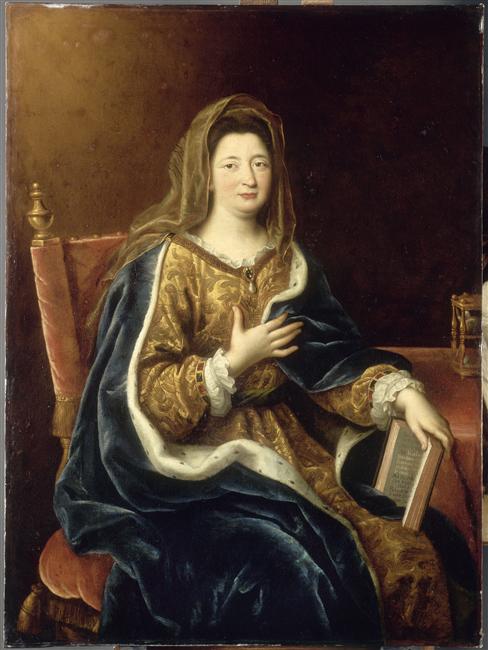
The creation of such a school was a project very dear to Madame de Maintenon. She came herself from a poor noble family, lost her parents early, and received a mediocre education in various convents and by various relatives. Convents were pretty much the only option for noble girls to learn about the world, but what they were taught there was very limited and focused on religious matters. They learned just enough mathematics to deal with numbers regarding their Households once they were married, they learned a little Latin and how to read and write French, along with what was considered helpful for their future roles as wives. Nothing too substantial and nothing that would prepare them for the world as it was.
The Marquise wanted to create a place where impoverished girls from noble houses could be educated better and with slightly more liberties, which could then lead to better marriages and a better future for the girls. At the time of the founding of the school there were plenty of impoverished girls from noble houses and it were getting more and more. All the wars the King waged took their toll. The fathers of the girls, were either killed in battle, wounded in battle and unable to serve any longer, crippled or missing limbs, or they had simply exhausted the family fortune for the King.
Madame de Maintenon met two ladies in 1680 who ran a similar project already. Madame de Brinon and Madame de Saint-Pierre, former ursuline nuns, ran a school for poor girls where those girls were trained for domestic services. She teamed up with them in 1681, rented a house at Rueil, had it furnished, and added twenty girls from the poor nobility to the the poor common girls. In different classes, of course. The noble girls had a different teaching schedule. On 3 February in 1684, the noble girls were relocated to the Château de Noisy. Louis XIV kindly offered Madame de Maintenon to use the Château for the purpose and had it fitted to host 180 pensionnaires.
The school became rather dear to Louis XIV as well and so he ordered, on 15 August in 1684, the creation of “a house and community where a considerable number of young girls, from noble families and particularly those whose fathers have died in the service… are housed for free… and receive all the educations suited to their birth and their sex… so that after having studied in this community, those who leave it can be examples of modesty and virtue in all the provinces of our kingdom…” called the Maison Royale de Saint-Louis.

A school like that needed of course a building suited for the purpose of educating and housing those girls. The King chose the domaine de Saint-Cyr, just behind Versailles, and entrusted Jules Hardouin-Mansart to design and build a fitting house. Mansart created a large building (see picture above) with a chapel to the west. The rooms for the students and mistresses were located in the centre (the part forming an H, Madame de Maintenon’s rooms are on the upper left of the H and stretch out from the part marked B up to the part marked C), with the classrooms being on the first floor and the dormitories above them, sorted by classes. Each of the dormitories had 40 beds and two small rooms for the respective mistresses in charge. Each classroom, located straight under the dormitory of the specific class, also had an extra smaller dormitory of 20 beds next to it.
An isolated infirmary, for ailing girls, was added as well. The building was constructed in such a way that the girls would hardly come in contact with visitors, for their dormitories and classrooms were located in the east of the building, while the entrance was on the west, with two courtyards in between. Madame de Maintenon was quite paranoid the innocence and piety of the girls could be spoiled due to flattery from male visitors.
Louis XIV gave the domaine to the Maison Royale de Saint-Louis in June 1686 and the girls/pensionnaires, from then on known as the Demoiselles de Saint-Cyr, moved in between 26 July and 1 August with great pomp. The King borrowed them his carriages and Swiss Guards for it.
Madame de Maintenon became the Institutrice de la Maison Royale de Saint-Louis -Headmistress-, which granted her say in all matters, and Madame de Brinon was named Supérieure à vie -superior of the school for life-. The King visited the school for the first time in September 1686 and was greeted with equal pomp by its inhabitants.
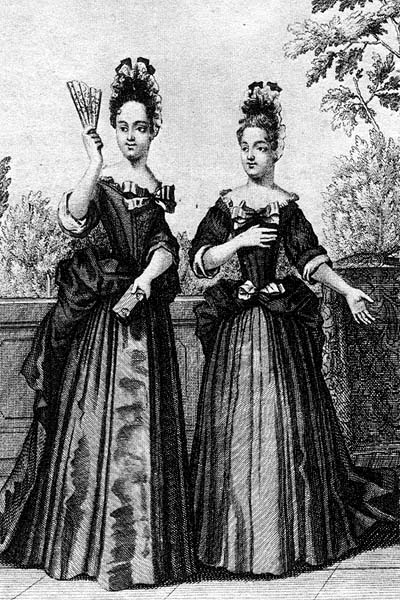
Said inhabitants, “daughters of gentlemen who have been killed or exhausted their health or their fortune in the service of the State” entered the Maison Royale aged between seven and twelve. Who could be admitted to enter was in the hands of Louis XIV. To enter, applicants needed at least four generations of noble birth on their father’s side, which experts on French genealogy checked, and their families had to be too poor to support the girl in question in matters of education. The Maison Royale could host 250 girls and had 36 female teachers, called professes, along with 24 sisters for domestic tasks, called converses, as well as priests and lower servants.
Madame de Maintenon came up with the idea for a school uniform that also allowed to easily spot which girl belonged to what class. She ordered brown Mans muslin gowns similar to court gowns, consisting of a coat and a skirt, with a bonnet of white canvas and lace, which allowed the hair to be slightly visible and to which ribbons of a certain colour were added. The girls were divided in four glasses and each glass had a different ribbon colour assigned. Red ribbons for the class consisting of girls aged seven to ten. Green for girls aged eleven to fourteen. Yellow for those aged fifteen to sixteen and blue for those aged seventeen to twenty.
Some especially talented students of the blue ribbon class could exchange their blue ribbons for very special black ones. A dame titled Maîtresse générale des classes was in charge of all classes, during and after school hours, and four maîtresses de classe were in charge of each of the classes, assisted by a maîtresse secondée and a maîtresse deuxième as well as sous-maîtresses. If one of the blues was especially talented and disciplined, the maîtresse de classe could award the girl with a black ribbon, which allowed the girl in question to act in support of the various maîtresses, for example when dealing with accounts and such things.
These maîtresses, dressed in black muslin and black bonnets, were not proper nuns, as one would think, but only took simple or temporary religious vows of poverty, chastity and obedience along with a vow to devote their life to the education and instruction of the Demoiselles. That the personnel of the Maison was lay and not religious, was unique for the era.
When the Demoiselles celebrated their twentieth birthday, it was time to leave the Maison Royale. They received 3,000 livres upon the occasion, which they could either use as dowry or to enter a convent of their liking. There was also the possibility to remain at the Masion Royale as a teacher, for which the girl was trained by a maîtresse des novices for six years. Of course, one could also leave the school earlier, but that only if dismissed for misbehaviour, if a marriage was arranged or due to exceptional family circumstances.
What the girls learned depended on in which class they were. In the red class they learned the basics, how to read and write, along with arithmetic, and received their first lessons in matters of catechism, the rudiments of religious history and Latin. The green class they continued their previous studies and also learned about general history and geography. For the yellow class, drawing, singing, dancing and music was added. For the blue class, these studies were intensified and lessons on heraldry, the history of the Catholic Church and detailed teachings in matters of morality added. Everything in the spirit of les Constitutions, the schools special rules: First to learn of God and religion… They must be inspired with a great horror of vice and a great love of virtue… They must learn the duties of an honest woman in her household, as regards her husband, children and servants… They must learn to bear themselves with a good grace… they must learn to read perfectly, to write, spelling, arithmetic… Those meant for service must learn to comb, to dress hair…

The Demoiselles had strict daily schedules, yet not as strict as it they were in convents. The girls rose at 6 o’clock in the morning, in convents the usual time to rise was 4 o’clock, and gathered in their classrooms at 7 o’clock for prayer, after which they had breakfast. Class began at 8 o’clock and lasted until 12 o’clock, after which the girls had lunch and time off until 2 o’clock. Class began again at 2 o’clock and lasted until 6 o’clock, followed by prayers and supper and time to study until bedtime at 9 o’clock. Helping with the domestic tasks was part of the schedule for every class. For the blues and blacks, helping with the domestic tasks was a must and also extended to assisting in the refectory and infirmary, as well as sewing and repairing the gowns of their fellow students or their teachers. In their leisure time, something of importance to Madame de Maintenon, they could read, chat or play chess. Card games were forbidden, for it was thought they could encourage the girls to gamble. The students were allowed to meet with their families, only in the parlour and not more than four times a year, but were not allowed to leave the Masion Royale on something like school holidays. There were none. The girls were only provided with cold water to wash and their beds featured hard mattresses on purpose, in order not to spoil them.
Madame de Maintenon made changes to how the school was run in 1698, by splitting each class into sort of families. They consisted of eight to ten girls, with the eldest of them acting as a sort of mother. The Mémoires des Dames de Saint-Cyr from 1699 state: “Madame de Maintenon, to better improve their conduct, thought of separating them into bands and substituting for the two big tables six or seven smaller ones, which would each have a fixed number of Demoiselles, with the students not allowed to sit anywhere else without instructions from the Mistresses. She made a first attempt at a small class size, and when this proved a success, the same thing was observed by the other classes and still remains to be seen to this day.”
The general goal of the Maison Royale de Saint Louis was to prepare the girls for their future roles as wives and ladies of nobility. Thus they also were educated in matters of arts, something no convent did especially when acting was involved. The girls of Saint-Cyr however received theatre lessons and staged plays quite often. One play staged at Saint-Cyr, Racine’s Esther, caused a lot of fuss between the Mesdames de Maintenon and de Brinon and a bit of an scandal.
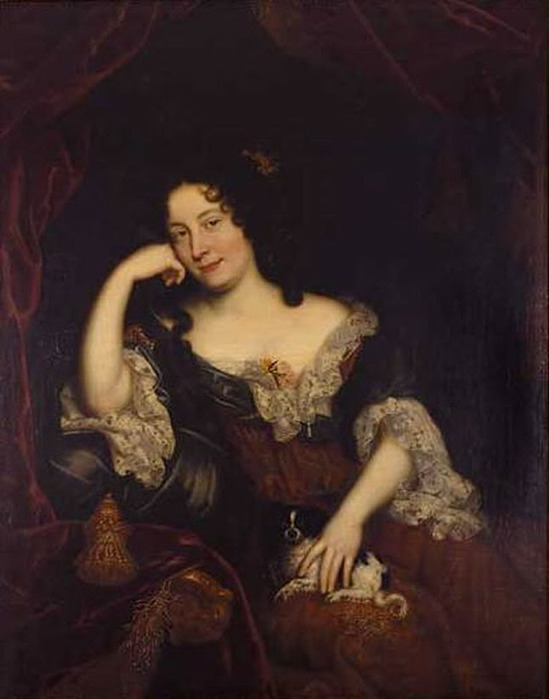
The Sun King loved the theatre. In his youth, he laughed about comedies, later on he saw himself as the hero of the great dramas, as he grew older he became also fond of plays with religious topics. Madame de Brinon was the author of the first plays the Demoiselles de Saint-Cyr performed and Madame de Maintenon wrote for them the so-called Conversations on different matters of moral. Later on, the girls took to studying and performing plays of Corneille and Racine…. which was a bit of a problem for Madame de Maintenon. She was of the opinion that the romantic scenes in said plays, were not proper to be performed by the Demoiselles de Saint-Cyr… because it might give them ideas. Thus Racine agreed at the request of Madame de Maintenon to write something more fitting, aka something involving religion, for the girls.
He proposed the topic of Esther, from the biblical Book of Esther, which relates the story of a Hebrew woman in Persia, born as Hadassah but known as Esther, who becomes Queen of Persia and thwarts a genocide of her people. A topic utterly fitting fot Saint-Cyr in the eyes of Madame de Maintenon… and knowing that her girls were rather skilled at acting, she invited King and court to witness… which did annoy Madame de Brinon quite a lot. She thought Madame de Maintenon’s reason to invite King and court was a desire for personal glory. It was not the first argument between the Mesdames concerning the school. Madame de Brinon complained for a while already that Madame de Maintenon got too involved in it all, the running of the school, which was the job of Madame de Brinon, and how she tried to impose certain things on Madame de Brinon. If you know the character of Madame de Maintenon, you can be sure that she was not happy with such opposition at all. Luckily, she was the secret-not-so-secret wife of the King and the latter ordered the play to be performed by lettre de cachet. Madame de Brinon, although being the superior for life, was replaced by the twenty-two year old Madame de Loubert, former secretary to Madame de Maintenon, and withdrew to the Abbaye de Maubuisson.
Louis XIV and Madame de Maintenon were present as Esther premiered on 26 January in 1689. Almost all of the girls who performed the play, were from the blue class…. and it was a big success. The King loved it, so did the court, and everyone was utterly impressed by the outfits the girls wore. Madame de Maintenon got them costumes decorated with diamonds and precious stones. The Mémoires des Dames de Saint-Cyr from 1699 say: “…so that nothing in this spectacle might be disagreeable to this Prince, she had Persian clothes made for all the Demoiselles who were to appear on the stage: they were very brilliant, ornamented with pearls and diamonds from the Temple, which had previously been used in the ballets.” The set was just as amazing, for it had been designed by Monsieur Borin, who happened to be the set designer of great court spectacles, and the music…. it was performed by the King’s musicians. The whole thing did cost over 14,000 livres and was performed several times in presence of selected courtiers. Being among those selected courtiers was considered a great honour… which turned out to be a bit of a problem for Madame de Maintenon. While she very much enjoyed to have pleased King and court, she was not happy at all about the attention the Demoiselles received and feared for their very souls.
All those courtiers, male courtiers among them, praised their skills, their grace, their elegance… their looks. All of that could inspire ideas. “So innocent and pious was the spectacle that attracted the whole world, it could by frequent visits become prejudicial to the Demoiselles; it was this that brought criticism from the M. l’abbé des Marais and the Messieurs des Missions Etrangères: they believed that the applause of the King and the whole Court could form a trap capable of undoing the good Madame de Maintenon wanted to establish, that [the students] might give themselves over to vanity and love of the world from which they might find it difficult to return.” – Mémoires des Dames de Saint-Cyr.

Thus, to avoid any reason for praising, Madame de Maintenon did not want to have the girls perform plays anymore. Louis XIV was of a different opinion. He wanted them to perform Racine’s new play Athalie. (Athaliah seized the throne of her hubby Judah and ordered the execution of all possible claimants to the throne, then abandoned the Jewish religion for the worship of Baal, thinking all claimants are dead and not knowing one, Jehoash, was rescued.) Madame de Maintenon did not like that much, but had to give in. The play was staged, but with great discretion and under exclusion of the court. The Demoiselles had no sparkling costumes this time either, just their normal school gowns. Only the royal family was allowed to attend the play, with the exception of one performance, for which various Bishops and the exiled James II and Mary of Modena were invited.
For Madame de Maintenon’s religious guide, François Fénelon, she and the Maison Royale had become way too glory-seeking. He demanded that humility should play a bigger part in her life, which was also extended to the school rules. The Demoiselles were forbidden to engage in any form of coquetterie and vanity. Certain books not dealing with religious or pious matters, that previously were allowed to be read, were banned and considered too indecent to be read by the girls. It was recommended by Madame de Maintenon that their teachers should not hesitate to punish the girls, in order to contain their pride and because the girls “were too considered, too caressed, too contrived, they must forget themselves in their classes, be made to obey the rules of the day and not speak of anything else”. For that reason, Madame de Maintenon also demanded that all males, except priests, were no longer allowed to enter Saint-Cyr and that the priests may only be allowed to meet the students in the confessional, nowhere else.
One could think that imposing those new rules, would have shut the Esther ado down… but far from it. The church was not happy and condemned the production of Esther, as well as the lack of discipline which apparently reigned Saint-Cyr, adding the reason for it was that the education of the Demoiselles had been trusted into the hands of lay people and not proper people of the church, as it was the case in convents. That Saint-Cyr was not a convent, but a secular house, was another reason for complaints. The church said it was improper a secular house was financed with revenues from the Abbaye de Saint-Denis, to which the Masion Royale was attached.
Madame de Maintenon saw her attempt to create a school for poor girls from the nobility failed. She never wanted the school to become a convent, but considered it the only option left. Secular education obviously did not work. The transformation of the Masion Royal into a convent decided on in September 1692. By December, it was Augustinian convent and its teachers were given the option to leave said convent or, if they wished to continue teaching, to take their vows and become nuns.
And just as one scandal was over, the next one followed. Madame Guyon, a friend of Madame de Maintenon, had been welcomed to the Maison Royale in 1689. This Madame Guyon was a very religious woman and accused to be a Quietist. (Quietism is the name given to a set of Christian beliefs that rose in popularity in France, Italy, and Spain during the late 1670s and 1680s. It was condemned as heresy by Pope Innocent XI.) The church was not happy said lady influenced the Demoiselles with heretical thoughts and strange ecstasies. Madame de Maintenon had to dismiss Madame Guyon in 1694 and also broke with Fénelon, who supported the ideas of said lady.
Madame de Maintenon spent more and more time at Saint-Cyr in the 1700’s and retired there after the death of Louis XIV in 1715. She died there on 15 April in 1719 and was buried in the school chapel.
While some of the illegitime daughters of Louis XIV were schooled briefly at Saint-Cyr, and also Marie-Adélaïde de Savoie, the mother of Louis XV, Louis XV refused to send his daughters there to be schooled. He considered the education provided there to turn the girls into prudes. The Marquis d’Argenson wrote in 1750: “We know the establishment at Saint-Cyr is good for nothing. It produces nothing but prudes, who only marry in their provinces or are made to enrage their husbands.”
The French Revolution put an end to the Maison Royale de Saint-Louis. It was closed in 1793 and the buildings at Saint-Cyr served as a military hospital for the next five years. Under Napoleon, the École spéciale militaire de Saint-Cyr into the former building of the Maison Royale, where it remained until World War II. Now the buildings host the Lycée militaire de Saint-Cyr.


